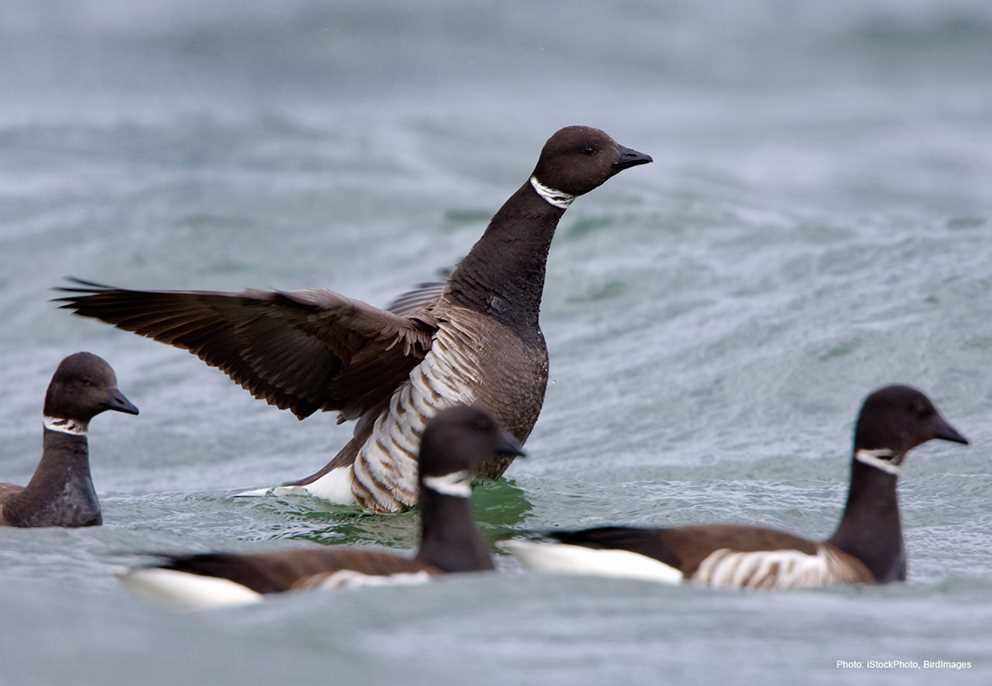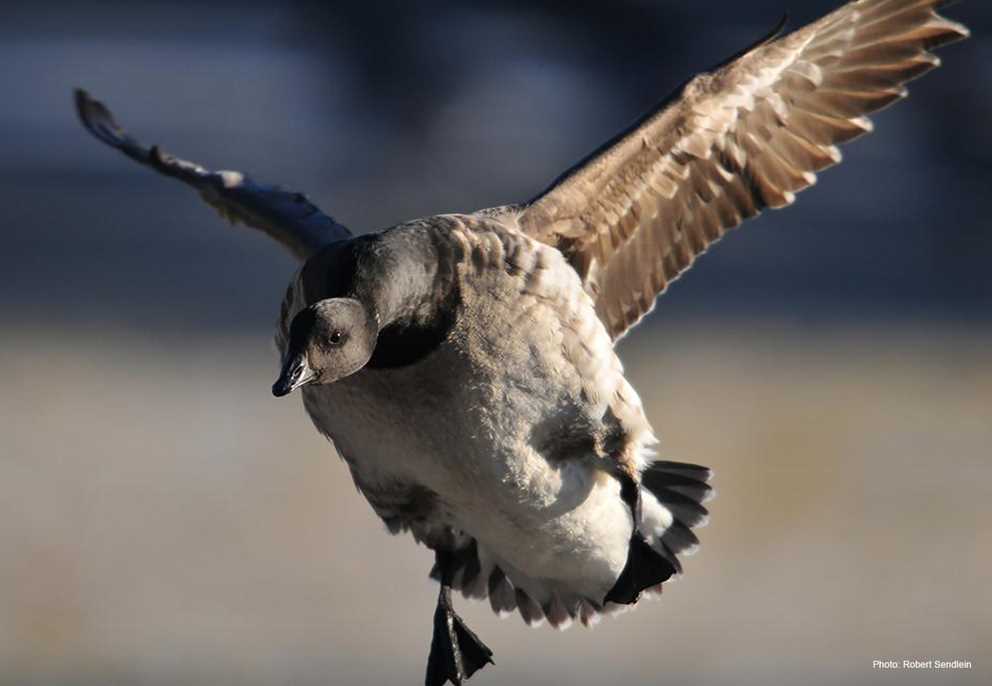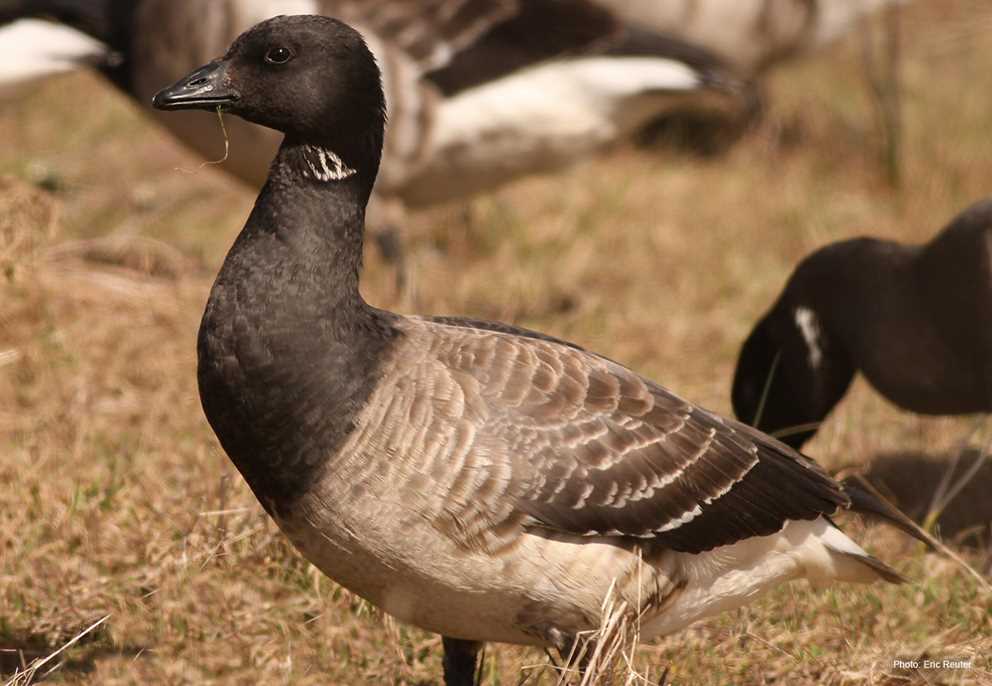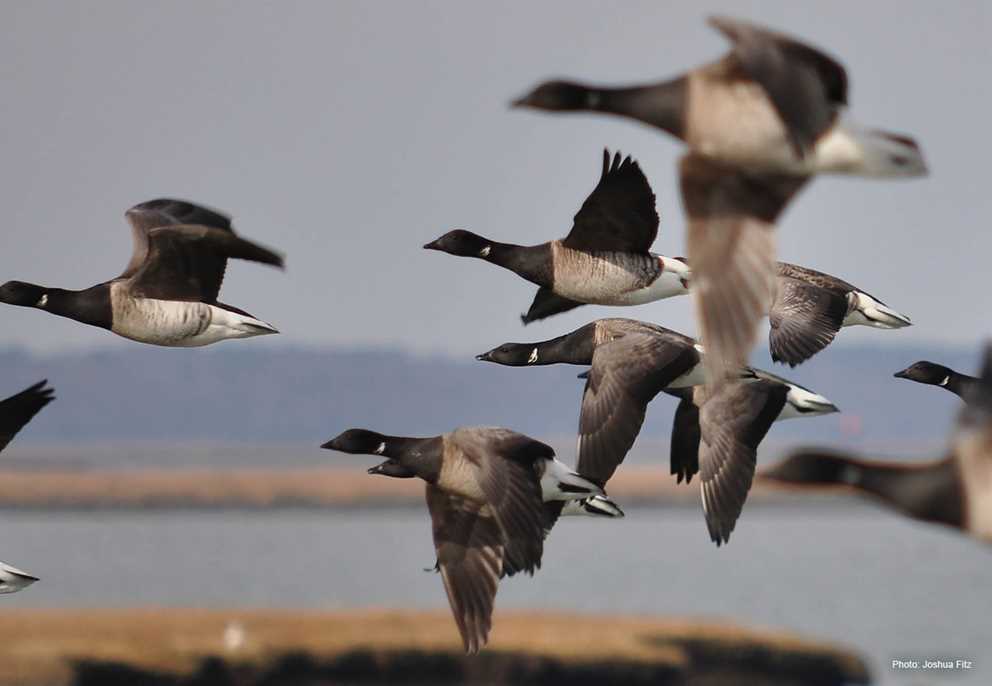Overview
Brant are small Arctic-nesting geese with a circumpolar distribution. In North America, Brant nest in arctic areas from Alaska, across Canada to Ellesmere and Baffin Island. In the Pacific Flyway, they winter mainly from coastal Vancouver Island, British Columbia to Baja del Sur, Mexico. In the Atlantic Flyway, they winter in coastal areas from about Massachusetts to North Carolina. Two subspecies are recognized in North America, the Atlantic Brant (B. b. hrota) and the Pacific Brant (B. b. nigricans).
Brant have a short, black bill, black head and neck, with a narrow, white necklace that is larger on the Pacific subspecies compared to the Atlantic subspecies. The breast is black, while the back, flanks, and wings are dark gray- brown. The rump and vent are white, with the rump contrasting with the back, and due to broad, white edging on otherwise black tail feathers. The belly of the Pacific subspecies is dark gray, whereas that belly of the Atlantic subspecies is light gray.
Brant almost exclusively use coastal or marine waters. During migration and winter they forage heavily on intertidal vegetation, especially seagrass.
Description
Key Identification Features
- Brant are small, geese, closely associated with coastal waters.
- The Pacific subspecies has a black head, neck, and breast, with a white necklace on the neck that is wider and more conspicuous than in the Atlantic subspecies.
- The back, flanks, and wings appear dark gray-brown.
- The Pacific subspecies has a dark gray belly compared to the light gray belly of the Atlantic subspecies. The rump, vent and tail are white, with the broad, white edging on black tail feathers.
- In flight, wings appear long, and the wing beats are rapid compared to other geese.
Male/Female Average Length and Weight
- Weight: Males 2.60–4.06 lbs.; Females 2.27–3.70 lbs.
- Wingspan: 45 in.
Male and Female Identification
- Alternate (Breeding) and Basic Plumage: Males and females are similar in appearance. Brant are small, dark geese, with a short black bills, black heads and necks. A distinguishing feature is a narrow white necklace that is larger on the Pacific subspecies than the Atlantic subspecies. The breast is black, while the back, flanks and wings are dark gray-brown. The rump and vent are white, contrasting with the dark back. The belly of the Pacific subspecies is dark gray, while that of the Atlantic subspecies is light gray.
In-Flight Identification
- In flight, wings appear long, and the wing beats are rapid compared to other geese.
- Broad white edging on black tail feathers creates a characteristic “V” shape in flight.
Vocalizations
- A guttural cronk, or cut cut cut cronk when in flight.
Similar Species
- Unique in appearance and unlikely to be confused with any other species of goose in North America. Canada Geese and Cackling Geese are two other species of “dark geese,” but both have diagnostic white cheek patches that are absent in Brant.
Habitat Preferences
- Breeding: Brant nest in loosely aggregated colonies in the Arctic coastal tundra. Nest colonies are usually close to water, and less than a yard (one meter) above the high tide line. Nests are often in areas of low or scattered tundra grasses.
- Migration and Wintering: Brant use coastal bays, favoring intertidal areas with abundant sea grasses. Pacific Brant typically do not use agricultural habitats and are exceedingly rare inland in North America. In contrast, Atlantic Brant are often found foraging in upland turf grasses as an adaptation to the loss of preferred seagrasses on the Atlantic Coast.
Foraging Habits and Diet
Brant primarily eat eelgrass, green algae, and other intertidal plants. They feed almost entirely on vegetation. They feed by grazing, tipping up, grubbing for roots, and picking floating vegetation. On the Atlantic Coast, brant may be found foraging on turf grasses in upland areas.
Breeding Habits
- Monogamy: Perennial monogamy, usually forming lifelong pair bonds. Timing of pair formation is poorly known but probably occurs during winter of second year.
- Brant typically attempt first breeding at two years of age, although some may not breed until age three.
- Nest initiation usually late May–June, but varies with dates vary with arrival date and spring ice conditions but usually are late May–June.
- Nest Locations: Nest is usually a depression created by the female, with vegetation and down added as laying progresses.
- Clutch Size: 3 to –5 eggs. Eggs are light buff to creamy white, and long-elliptical in shape, averaging 2.8 by 1.9 in diameter. Incubation period is 23 to 24 days, with females performing incubation duties. Males provide nest defense.
Migration and Distribution
They depart breeding areas in late August and September. The Pacific subspecies makes extensive use of Izembek Lagoon near Cold Bay, Alaska, for staging during September and October. The Atlantic subspecies stages along James Bay. Brant begin departing for winter destinations in October. Pacific Brant largely migrate over water direct to Baja from Izembek, though some birds may stopover in coastal bays and estuaries along the Pacific Coast. In recent decades an increasing percentage (40–50 percent) of Pacific Brant are overwintering on Izembek Lagoon. Atlantic populations migrate nonstop overland from Hudson Bay to the Mid-Atlantic coast. They arrive on wintering areas in October or early November. Spring migration is more protracted, with stopovers at staging areas and arrival on breeding areas in late May.
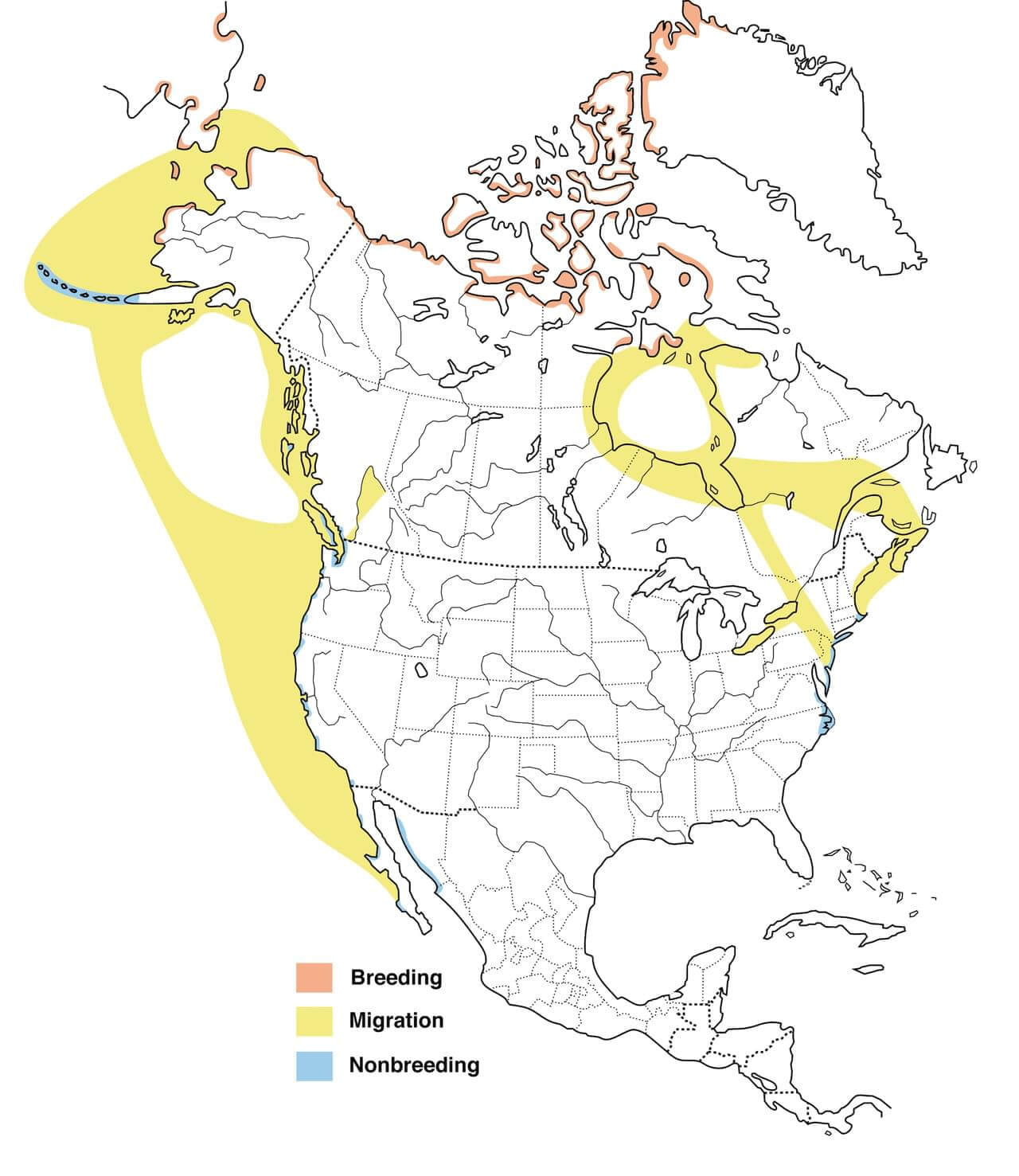
Conservation Status
- IUCN Status: Least Concern
- Population Status: The global population of Brant estimated at 400,000 to 500,000. North American population estimated at approximately 185,000 Pacific Brant and 180,000 Atlantic Brant.
- Conservation Concerns: Primary threats include habitat loss, variable breeding success related to late spring ice conditions, harsh winter conditions, and loss or decline of seagrasses in important wintering areas.
- Conservation Focus: Conservation efforts focus on protecting habitats, ensuring appropriate harvest levels, and maintaining long-term research studies to monitor changing population dynamics.
Harvest Information
- An average of 16,104 Brant were harvested annually across the US from 2019 to 2022.
- Brant harvest is typically highest in the Atlantic Flyway, accounting for 60 to 70 percent of the total US harvest.
- The top three harvest states for Brant during across the 2019- 2022 hunting seasons were New York (3,589), New Jersey (3,056), and Alaska (2,807).
- Subsistence hunting in Canada and Alaska accounts for the harvest of 10,000 to 15,000 brant annually.
